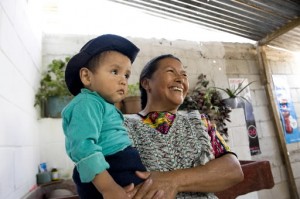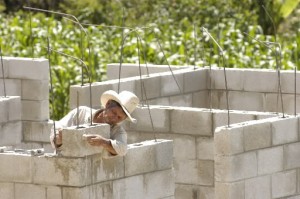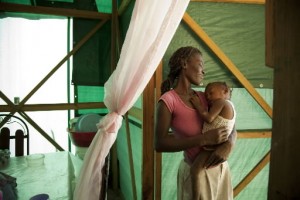Housing Series: The Critical Shift Toward Asset Building
Editor’s Note: The following post is part of NextBillion’s month-long series in partnership with Ashoka focused on affordable housing issues. Please follow the entire series HERE and join the discussion with your thoughts and insights.
For more than two decades, the partnership between the Citi Foundation and Habitat for Humanity International (Habitat) relied heavily on a “one house, one family,” volunteer house-building model. As a result, more than 500 Citi-sponsored homes were built with the help of Citi volunteers. While this is no small feat, we know this it is simply not enough, nor is it a sustainable solution.
The need among the world’s poor far exceeds what can be achieved through house-building programs alone. A shift to a strategy that increases the supply of financial products and services that accelerate financial inclusion is urgently needed. Our two organizations have already started working together to make this shift, which we will detail later in this post.
With increasing demand for both access to affordable housing and appropriate financial products across the globe, our organizations realize that an enormous opportunity exists: one that provides products that help low income households build assets that can be used to improve living conditions and more importantly, to join the financial mainstream and accelerate financial inclusion. The growth of microfinance to now provide savings, credit, insurance, and remittance services to nearly 200 million of the world’s poor, has created a platform of varied institutional types that we believe are ready to begin taking on new strategies to help clients build assets that improve their living conditions.

(Pictured left: Guatemala City, Guatemala – Juanita Alvarado and her grandson Javier stand in front of their home. Image credit: Ezra Millstein.)
In fact, expanding the range of products offered to the base of the pyramid was rated as the second highest priority by financial inclusion industry participants in the Center for Financial Inclusion’s recent publication “Opportunities and Obstacles to Financial Inclusion.“[1] (See NextBillion posts on this report here and here). This, coupled with research well-documented in the 2009 book, Portfolios of the Poor, affirms that property and housing were the first or second investment priorities for low-income individuals surveyed in Bangladesh, India and South Africa. What makes this even more compelling is the fact that already we see that up to 30 percent of microenterprise lending is used for clients’ shelter-related needs.
This is not surprising, as a home often plays a prominent role in household livelihoods, frequently serving as a warehouse, production site, rental rooms for tenants, or as a sales windows. Armed with this knowledge, we conclude that to make a catalytic shift, we must focus on creating the “next generation” of microfinance products.
We know we must take into account the demand for new products and the need to innovate to reach scale. We already know that savings has a special role in improving one’s living condition in other sectors, and it likewise can have significant relevance in the housing sector. Property, housing, and infrastructure can be both a use of, and a form of, savings. The poor’s ability to save, and their desire to do so, is increasingly documented in research and practice. In fact, the outrageously high costs they incur to do so indicate the value households place on the ability to save.
The Citi Foundation’s belief that savings is a critical element to establish long-term financial security and a way for the poor to participate in the economy gave us an opportunity to link savings closely with household plans to build assets and improve living conditions.
Habitat’s focus on moving beyond microenterprise credit and designing new housing microfinance products started with the Citi Foundation’s support in Latin America and this innovative asset building approach is now advancing our work in Asia Pacific. Here are additional details about how we are seeking to test this new approach in these regions.
Habitat’s Center for Innovation in Shelter and Finance
HFHI launched the Center for Innovation in Shelter and Finance (CISF) to collaboratively work with a wide variety of actors in the public, private, and third sector, many of whom have not yet applied their strengths to shelter and housing. In the financial service sector, actors such as MFIs, cooperatives, banks, microfinance networks, development finance institutions, impact investors and consulting firms all will be needed to take shelter solutions to meaningful scale. The CISF provides advisory services and knowledge management of promising practices around shelter finance, starting with the experiences obtained in recent years with Citi Foundation funding. In the next five years, Habitat will work with 60 institutions to develop the financial services that could potentially benefit more than 40,000 households – creating an estimated $40 million funding stream for shelter asset building with $8 million coming from household savings.
We are already moving forward by piloting the Housing Microfinance Toolkit that presents a methodology to help financial service providers design demand-driven housing finance products and housing support services for home improvements. The toolkit was designed and tested in collaboration with Latin American MFI partners – ADEMI, ADOPEM, ASPIRE, FIME and MUDE in the Dominican Republic – and ProMujer-Argentina and Vision Banco in Paraguay. It will be available for a global audience next year.
(Above Image: Aldea Los Regadillos, Chiantla, Guatemala (2006) – Alfonso Rodriguez helps to build a house his daughter Ofelia will own and occupy with her family. Image credit: Steffan Hacker).
Citi-Habitat Home Improvement Microsavings Program
Our most recent joint initiative further advances Habitat’s new approach to catalyze innovation within the microfinance sector. With a US $1 million commitment from the Citi Foundation, Habitat is launching an innovative three-year multi-country microsavings and financial education initiative. The Citi-Habitat Home Improvement Microsavings Program will target communities living in substandard housing in the Philippines, Thailand and Vietnam that are regularly exposed to and especially vulnerable to natural disasters, such as flooding and typhoons. By providing savings products, financial education and construction technical assistance, the program aims to help 3,000 low-income homeowners save a total of US$2 million to strengthen their homes against disasters.
This initiative demonstrates Citi’s commitment to financial inclusion by developing a scalable savings model. It also expands Habitat’s ability to provide housing support through new product design for the benefit of low-income families to improve their homes.

Indeed, based on the experience of our two organizations, the consensus of numerous researchers and the responses of our clients, we believe a multi-stakeholder approach represents a new model for growing the assets of the poor, while reducing the 1.6 billion living in below-standard housing around the world.
(Pictured left: Cabaret, Haiti, 2010: Islande Isnardin, 32, lives with her husband and two small children (including son Silvenson, who is almost 2) in a transitional shelter. Image credit: Steffan Hacker)
Patrick Kelley co-authored this story. Patrick serves as Director of International Housing Finance for Habitat for Humanity International’s work in more than 80 countries worldwide. His responsibilities include directing Habitat’s global strategy for sustainable housing finance, developing shelter-related products and services with local financial service providers through HFHI’s Center for Innovation in Shelter and Finance, and sourcing capital to bring housing solutions to scale. As a part of his role, Patrick served as the coordinator of the CGAP Working Group on Housing Finance.
Prior to Habitat for Humanity, Patrick worked in Africa supporting microfinance institutions, savings-groups, and national microfinance networks. He served as executive director of URWEGO LLC, the largest MFI in Rwanda, and initiated the start-up of Turame in Burundi, and Hekima Cooperative in the DRC. Both URWEGO and Turame were awarded Best MFI in Country by the UN “Year of Microcredit” Campaign. Patrick also introduced a non-mortgage housing finance product in Rwanda, and has previous housing experience in Latin America.
___________________________________________________________________________________
[1] See the recent publication “Opportunities and Obstacles to Financial Inclusion” by the Center for Financial Inclusion (Publication 12, 2011, p. 39).
[2] Collins, D. et al. “The Portfolios of the Poor”, 2009, p. 108.
Please like NextBillion on Facebook, follow us on Twitter and/or join our LinkedIn group.
- Categories
- Finance, Uncategorized

